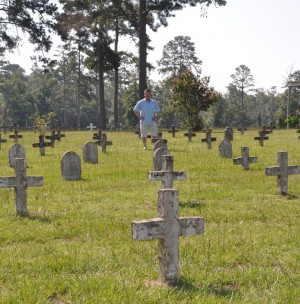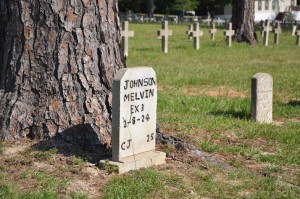The Capt. Joe Byrd Cemetery in
Huntsville is the final resting place for inmates who died in
the Texas prison system and were unclaimed or whose families
simply could not afford to bring them home, including infamous
serial killer Henry Lee Lucas and two-time Death Row inmate
Kenneth McDuff, as well as Kiowa Indian Chief Satanta,
imprisoned in 1874 for leading raids on Texas settlers.
|
But those are not the stories Frank
Wilson wants to tell.
|
The SHSU doctoral
graduate and assistant professor at Indiana State University is
writing a book about “America’s common ground” found among the
headstones on a quiet hill on Bowers Boulevard, just a few
blocks from Sam Houston State University and the Huntsville
“Walls” Unit.
|
| “As I went through
the cemetery and took pictures of each of the 3,000 headstones,
I could see some were veterans, and I saw that some families had
placed flowers and trinkets on the graves,” Wilson said. “I
reflected on the statement ‘There but for the grace of God go
I.’ I could have wound up here had certain things not happened
in my life.

America's Common Ground
|
| “What you are
looking at here is America’s common ground,” he said. “You have
individuals that everyone in the world has something in common
with. That’s what the book is about.” |
Among the neat rows
of headstone and crosses, Wilson found a man who fought in three
wars, World War II, Korea, and Vietnam. In fact, he found more
than 70 veterans buried in the cemetery.
|
“When you look back
and see his enlistment materials from Hoboken, N.J., and then he
fights in three different wars, and ultimately his end
culminated in a prison cemetery in Southeast Texas, you have to
wonder about this individual’s story,” said Dr. Wilson. “You
have over 3,000 individuals here that clearly have similar
stories, maybe some not as interesting, maybe some more
interesting.”
|
The cemetery, named
in honor of a longtime assistant warden at the Walls Unit who
had led a renovation of the graveyard in the 1960s, has been in
operation since 1850 and is the cemetery for inmates from the
Texas state prison system whose bodies went unclaimed. More than
3,000 people are buried here from prisons across the state,
including about 2 percent who were executed at the Walls Unit.
|
| Those graves are
marked with an “X,” an “EX,” or their inmate numbers begin with
“999,” signifying Death Row.

With many
of the older markers, only a name and execution date
are give on the headstone. This inmate was executed
in 1924 an his inmate number was 25.
|
Wilson spent the
summer of 2011 photographing each headstone in the cemetery.
While many headstones now include a person’s name and death
date, older graves are marked simply with the date of death and
a prison number. More than 300 of the earliest graves remain
unidentified; even prison officials don’t know who is buried
there.
|
“One of the reasons
for the book is to dispel some of the myths that surround the
cemetery, given its placement near the ‘death house’ in
Huntsville,” said Wilson. “Most people assume that the people
included in the cemetery are the ‘bad of the bad,’ or the worst
criminals. While in some cases it may be because that person
didn’t have a family to claim them, but in most cases it is the
fact that the family couldn’t afford to bring them home for a
burial.”
|
The Texas
Department of Criminal Justice pays about $2,000 toward each
burial, which includes a simple casket placed inside two plastic
shields. The chaplain of the Walls Unit leads the graveside
service at a central altar and, if no family is present, the
Walls Unit warden or his representative, along with officers and
inmates responsible for maintenance of the cemetery, attend the
service.
|
This summer, Wilson
returned to Huntsville to research archival information on the
cemetery at the Texas Prison Museum, the Walker County
Historical Commission and other museums throughout the state,
uncovering stories behind the men and women buried here.
|
Wilson became
interested in the cemetery while a student at SHSU.
|
It was part of his
daily running route, and he always wondered why and how a
person’s life could end in this remote prison cemetery.
|
While criminal
justice professor Dennis Longmire encouraged him to document the
prison cemetery as part of a dissertation, the final push for
the book came from his then 71-year-old mother, now 83.
|
“To this day, she
doesn’t mention NASA or anywhere else about her visit to Texas,”
Wilson said. “It is the prison cemetery she reflects on.”
|
Wilson said one of
the most important lessons he learned from SHSU was to develop
his own research agenda and explore new and innovative ideas. A
lesson he says he learned from such faculty mentors as Rolando
del Carmen, Longmire and Wes Johnson.
|
It was his mentors’
support that allowed him to study crime and media while at SHSU,
and as a result, he has founded the Annual International Crime,
Media and Popular Culture Studies Conference, which attracts
scholars from 15 counties. He also became the editor of the
“Journal of Criminal Justice and Popular Culture.”
|
Wilson said he
hopes his study of the cemetery will lead to a new area of
research in the criminal justice field.
|
“There is so much
history in these cemeteries that people shy away from because it
doesn’t fit the traditional standards of what is considered
criminology research at this time,” he said. “It is not a
database, not producing numbers or not leading to grants — yet.”
|
Wilson said prison
cemeteries offer a wealth of information.
|
“There are more
than 3,000 headstones here,” he said. “As a social scientist, it
makes me wonder what events in their lives lead them to be
here.”
|

Vote Montgomery County TXGenWeb County of the Month

